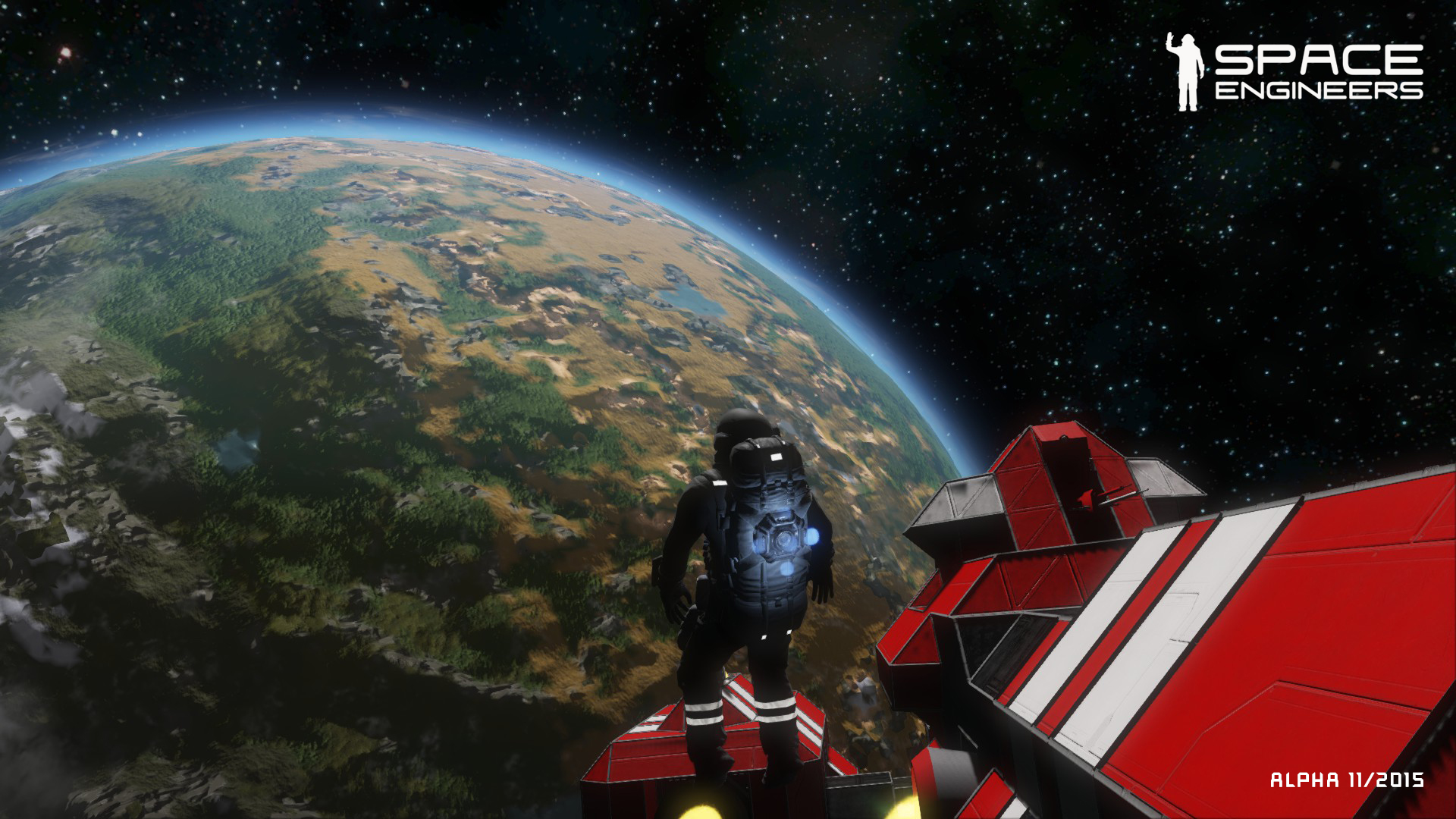Game Modes
Space Engineers is composed of two primary game modes: the Creative Mode, and the Survival Mode. Build freely and limitlessly, or survive by building and strategic planning.
Contents
Creative Mode
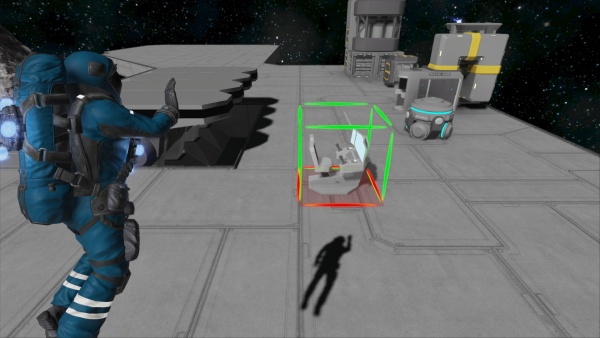
Overview
Creative Mode in Space Engineers is a free building mode that allows players the ability to place an infinite number of blocks, unlike Survival Mode where blocks must be constructed from Components, and welded in a time-consuming fashion. In Creative Mode, blocks are placed instantly; fully constructed, players are immune to damage; Hydrogen & Oxygen will not be consumed and are infinite. Batteries will quickly recharge themselves at all times. Objects can also be spawned instantly such as Asteroids, Blueprints, and other various items. Block placement reach is also extended up to 100m. Additionally, players are also able to construct scenarios while in Creative Mode for other players to play & explore.
Extended Block Placement
In Creative Mode, the player has more options when placing multiple blocks. Players can drag a single line of blocks with (default) – CTRL+LEFT-CLICK. Additionally, you can extend it horizontally/vertically with (default) – CTRL+SHIFT+LEFT-CLICK to create a large plane of blocks at once.
Copy/Paste/Delete
Players can copy any of their creations with the (default) – CTRL+C function. This saves the creation in the clipboard (only 1 may be copied at a time). The creation will remain in the clipboard till the player exits the game. So, copied creations from one world can be pasted into another loaded word.
To paste the creation back into the world, press the (default) – CTRL+P keys. You can use the block rotation keys to change its orientation, and the (default) – CTRL+MOUSEWHEEL UP/DOWN to increase or decrease the distance from your position. An additional feature of the paste function is that players may snap pasted items of the same grid type (ex: large blocks+large blocks or small blocks+small blocks).
There is also the option to delete a creation, this is done with the (default) – CTRL+X keys. A copy of the deleted object will always be stored on the clipboard and can be pasted back into the game.
Symmetry Mode
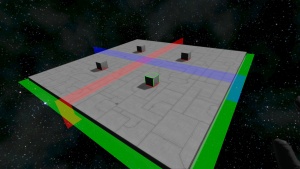
Symmetry Mode or “Mirror Mode” allows the players to place/delete blocks to two or more sides at once. It must first be set up with the (default) – M the key, then it can be used with the (default) – N key. Rotation and exact placement of the block(s) is mirrored onto the other sides. This mode can help players save a lot of time if both sides of a ship/station are made to be identical. This function is only available in Creative Mode.
To place a symmetry line (default) – LEFT-CLICK to place or move a symmetry line. Additionally, if you wish to remove it (default) – RIGHT-CLICK.
Setting Up Symmetry
Setting up Symmetry is done with the (default) – M key. Symmetry mode supports both odd and even structures, meaning that its central point does not have to be a single block, it can be two.
To shuffle between the X(Blue) Y(Green) Z(Red) axis, press the (default) – M key again. Each color will have two settings. The first sets the mirroring from one center block (odds). The 2nd sets the mirroring from two blocks on either side of the colored line (even).
- 1st Red – (Odd) Starts from a single block between mirrored sides
- 2nd Red – (Even) Starts from two blocks on each side of the mirror line
- 1st Green – (Odd) Starts from a single block between mirrored sides
- 2nd Green – (Even) Starts from two blocks on each side of the mirror line
- 1st Blue – (Odd) Starts from a single block between mirrored sides
- 2nd Blue – (Even) Starts from two blocks on each side of the mirror line
Spawning Objects
In Creative Mode, the player(s) can instantly spawn in nearly any object in the game, or from the workshop. This includes, but is not limited to – Components, Tools, Materials, Ores, ships, stations, asteroids, and planets.
- Adjusting Placement
Players can decrease/increase the range of the object they’re spawning from them with the Control – (default) CTRL+SCROLLWHEEL UP/DOWN.
Blueprints
Blueprints can be instantly spawned in Creative Mode via (default) – F10 without the need for a Projector, or Components. Any items that were inside the blueprint when it was saved will also be included when spawned. All blueprints when spawned in Creative Mode are set to Ownership – Nobody (neutral).
Additionally, players can save their blueprints faster in Creative Mode by copying the ship/station into the clipboard – (default) CTRL+C, and then going into the blueprint menu (default) – F10, and select “Create from clipboard”, or “Replace with clipboard” which will replace the selected blueprint.
Asteroids & Planets
Asteroids and Planets/Moons can be spawned in Creative Mode by going into the menu – (default) SHIFT+F10. Either pre-built models (ex: asteroids) can be inserted, or randomly generated objects using the procedural system.
Predefined
Predefined asteroids are pre-built models that players can spawn in the game. They range from mountains on planets to asteroids in space. They have no random generation.
Procedural
Procedural objects allow a player to randomly generate an asteroid with a different variation, and ore content each time. The variation can also depend on the size, and seed type the player chooses.
| Size | This slider determines the size of the object you want to spawn in. Only a minimum of 5m to 500m can be spawned with the procedural system. |
|---|---|
| Seed | A seed is assigned a random unique value. The root acts as a bar code and allows SE players to share unique asteroids they discover from other people or find on their own. However, it should be noted that any changes made to the asteroid by the player will not show in a newly created seed when spawned again. |
| Generate Seed | This action randomly produces a random seed (variation). |
Planets
Players can spawn their custom-generated Planets & Moons using the procedural generator. It allows a player to randomly generate a planet for example with a different variation to its surface each time it is spawned in with different seeds and size settings.
| Size | This slider determines the size of the object you want to spawn in. Only a minimum of 19km to 120km can be spawned with the planet spawn system. |
|---|---|
| Seed | A seed is assigned a random unique value. The seed acts as a bar code and allows SE players to share unique planets they discover from other people or find on their own. However, it should be noted that any changes made to the planet’s surface by the player will not show in a newly created seed when spawned again. |
| Generate Seed | This action randomly produces a random seed (variation). |
| Surface Type | Preset surface types can be selected and used when spawning on a new planet. ex)Earth-like will produce the same textures and planets as the preset Earth planet. |
Items
Items such as Components, Materials, Ores, and Tools can be spawned via (default) – SHIFT+F10. Their quantity can be adjusted, and then placed. It should be noted that ore quantity of Ore will increase in overall size if the value is increased.
Media
Tips
Known Issues
- When using Hydrogen Thrusters, even though they do not require fuel in creative mode, they still need a Hydrogen Tank attached to them for it to activate.
Survival Mode
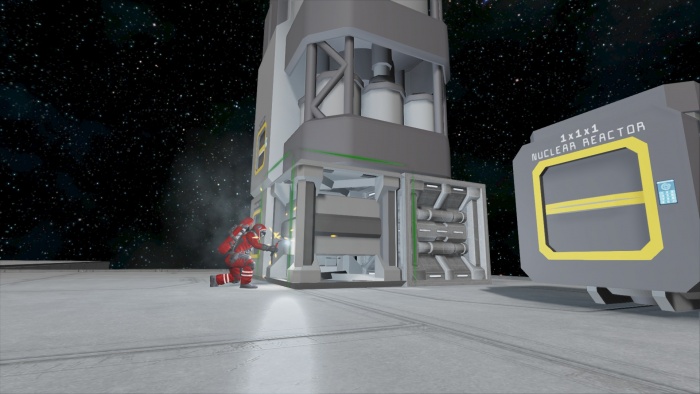
Overview
Survival Mode is a play mode introduced in Update 01.021.024. Unlike Creative Mode, Survival requires an investment of resources and introduces elements of real risk. Resources, both natural and artificial, need to be managed and death and loss of materials is a very real possibility. It might be easier to grasp if one remembers that the original name of this mode was “Realistic Mode”, which describes many aspects of the mode more clearly, but this name was not selected due to the gamer’s familiarity with the general idea of “Survival”. Note that without hand tools plus a powered Assembler and Refinery* an astronaut will be unable to build anything, making survival impossible. (* or the parts to construct them)
Life and Death
Survival introduces health, which when reduced to 0%, will result in death. This means that more complicated setups need to be made while aware of anything that might go wrong. There are several ways one can be damaged, including:
- Explosions
- High-speed collisions
- Falling (up or down; beware of Gravity Generators set too strong!)
- Gunfire
- Energy Loss (Which can lead to Asphyxiating below)
- Asphyxiating (Suffocation) (see Oxygenbelow)
Not all damage is lethal. If the Auto-Healing setting is toggled on, then damage will automatically start to (slowly) regenerate up to 70%. In either case, health can be renewed by visiting and using a Medical Room, which will also act as your respawn point should you perish.
Death
When dying and respawning in a Medical Room, there are currently no repercussions except for the loss of any items in that Engineer’s inventory, which can be retrieved by finding your engineer’s backpack (or body if still present) and looting it.
If there is no Medical Room present that can be used, engineers have the option of respawning in or out of a respawn ship a good distance away from the point of death and traveling back to reclaim their things.
Permanent Death
Permanent Death (if enabled) is the loss of control of blocks under the Ownership of the player. This occurs when the player dies and has no Medical Room in which to spawn at. Blocks that you lose Ownership of will treat you as hostile.
Space Suit
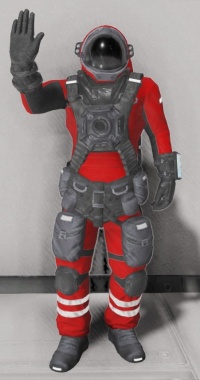
The Space Suit protects the wearer from the harsh environments in Planets and space. It regulates its energy supply, contains its Oxygen supply, Hydrogen fuel for the jetpack, and a built-in Antenna with a range of 200m. It has no means of defense against Weapons, therefore the wearer is quite vulnerable to weapons fire of any sort.
Jetpack
The Jetpack is what allows the engineer to free-roam in space & Planets. It allows for easier construction, maneuvering in environments with no Gravity, and climbing and breaking falls. Without it, players have no means of movement in non-gravity environments and are doomed till they run out of resources in their space suit. The space suit jetpack also comes with built-in Inertial Dampeners, which passively allow the engineer to automatically stabilize their position, or slow down.
Suit Power
In Survival Mode the concept of suit energy represents the limited-capacity battery included in every space suit. Your suit’s life support system slowly drains the suit’s battery passively, whether or not you are actively using any of your suit’s systems or Tools. When at 25% energy, a voice and a visual prompt will appear on the screen warning you of low energy. The energy indicator will turn red at 5% or lower, and another audio/text warning will remind you you are at critical energy levels. At 3% energy, you will not be able to use your jetpack. If your energy is ever depleted, your character will slowly asphyxiate as you’re unable to pump Oxygen in your suit, resulting in death if energy is not replenished immediately. Energy can also be replenished in a Medical Room, and will also be filled while sitting in a Cockpit, Fighter Cockpit, Control Station, Flight Seat, or Passenger Seat if the grid (ship) it is on is powered.
The suit battery is drained in a variety of ways, including:
|
Suit Oxygen
The space suit has an internal Oxygen tank to supply the player with breathable O2. While the player wears his or her helmet, the suit’s oxygen tank provides O2 to the player. The remaining oxygen capacity is displayed in the left status panel of the player’s HUD in [%] values. Oxygen supply in the suit can be replenished from Cryo Chambers, Cockpits, and Medical Rooms if they’re directly connected to Oxygen Tanks or an Oxygen Generator. Oxygen can also be replenished on the go from Oxygen Bottles, which will refill the suit when below 40%.
- For more information about the mechanics, see – Oxygen
Suit Hydrogen
The space suit’s jetpack requires Hydrogen to fly around. The remaining hydrogen supply is displayed in the left status panel. The player can regain hydrogen supply by either using a Medical Room that is attached to a Hydrogen Tank or with a Hydrogen Bottle in their inventory. The effectiveness of the jetpack changes depending if the player flies in space, in an artificial gravity field, or on a Planet/Moon with Natural Gravity. While in natural gravity, the lifespan of the hydrogen is heavily reduced. In addition, the stronger the local gravity is; such as when multiple Gravity Generators overlap. The more fuel the suit will consume in maneuvering about within this field.
Managing Power
Energy is not limited to just being managed within an Engineer’s suit in Survival. All Blocks with any sort of active function, including the Refinery, Assembler, and others, require power to operate. Even Conveyor blocks require power to function (see Conveyor Mechanics). Powered blocks need sources of Power such as Solar Panels or Uranium based Small Reactors and Large Reactors.
An important mechanic to note is that only Thrusters and Batteries will scale their performance based on the available power. (they can operate at less than full potential.) A Refinery or Assembler will not function when there is not enough power available.
Power (Uranium)
Uranium-powered reactors have the largest output in the game, far exceeding alternatives such as Solar Panels or even Batteries. They are fairly expensive to build and operate. Reactors require fuel in Survival Mode. The fuel source needed is Uranium Ingots, which are processed from Uranium Ore. Uranium consumption is based on the reactor’s output and efficiency. The ore can sometimes be difficult to locate on Asteroids or Planets/Moons.
Small Reactors are capable of powering systems that require a lot of power. However, as more Thrusters and blocks such as Refinerys or Assemblers are added, it quickly will be overloaded. The player can add more reactors, or build the more powerful and efficient Large Reactor.
The Large Reactors have 20x the output of a Small Reactor, but the Components required to build them are very expensive upfront. That being said, once built, they are capable of powering large amounts of powered blocks, and several Large Thrusters. Space-wise, it is far better to build one large reactor, than several small ones for the same amount of output.
Power (Solar)
Solar Panels are capable of generating power from direct exposure to the sun. While not able to output as much power as Small Reactors, they are a source of infinite power without any consumption of resources, except for the building of the solar panel itself. Blocks with high power consumption such as Assemblers, cannot be supported by a single solar panel with low demand on power such as Medical Rooms. When used in conjunction with Batteries, they are more than capable of rivaling uranium-powered reactors on a small scale.
Inventory
In Survival Mode Cargo Containers, and other blocks with an inventory have a capacity, this also includes the engineer (player) as well Inventory capacity can be modified in the World Settings of the world. Each item in the game has a set amount of space they take up when in an inventory.
It should be noted, that as more Components, Materials, Ore, etc you store on your ship, the heavier and less maneuverable it will become. See Thrusters for more information.
Block Construction
See also: Building#Building in Survival
In Survival Mode, all blocks must be constructed in stages before they are in a finished build state. Blocks are made up of Components, which can be piled into the block to slowly constructed into its completed stage with either a Hand Welder or Ship Welder. Welding speed can be modified in the World Settings.
Deconstruction
Blocks can alternatively be salvaged for their materials using a Hand Grinder or Ship Grinder. As the block is being deconstructed, its Components are placed in the engineer’s or ship’s inventories. Almost all blocks will return all of the same components needed for their construction. The exception for this is the Battery block. Grinding speeds can be modified in the World Settings.

